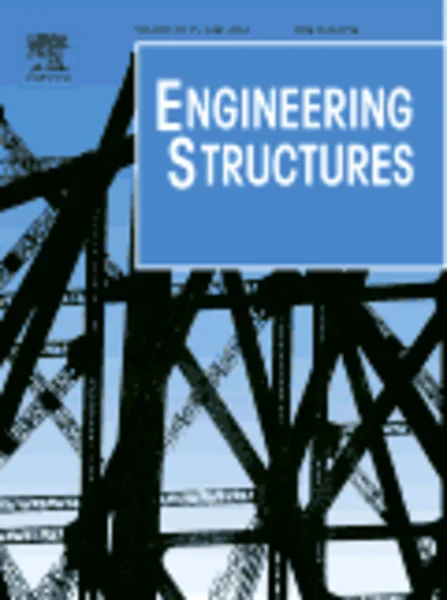-
a modified numerical vbi element for vehicles with constant velocity including road irregularities
جزئیات بیشتر مقاله- تاریخ ارائه: 1392/07/24
- تاریخ انتشار در تی پی بین: 1392/07/24
- تعداد بازدید: 812
- تعداد پرسش و پاسخ ها: 0
- شماره تماس دبیرخانه رویداد: -
there has been a growing interest to model and analyze vehicle–bridge interaction (vbi) of intricate vehicles on bridges. the objective of such an analysis is to realistically investigate the dynamic effects of moving vehicles particularly in case of high-speed trains, where the vehicle acceleration is a design criterion and should be calculated appropriately. one method of analysis is to eliminate the wheel degrees of freedom (dof) that are in direct contact with the bridge surface resulting in a vbi element, which is a modified beam element acted upon directly by wheel(s) of a running vehicle. the contact force is the mutual force between the wheel and the bridge. the available formulation in the literature is used to formulate the contact forces, which are related to those in the beam element dofs by the hermitian interpolation functions. considering suitable interpolation functions between the beam element displacement vector and those for contact points and also a new formulation for the contact points, a new formulation is proposed for the structural properties of the vbi element, resulting in a new element capable of capturing bridge and vehicle responses more realistically. a study is conducted on the model variables and their effects on the bridge dynamic amplification factor and also bridge and vehicle accelerations, in order to compare the new vbi method with the existing one. the studied parameters include vehicle and bridge damping, frequency parameter, system mass parameter, and a new parameter called vehicle mass parameter. results generally demonstrate noticeable differences particularly for high speed vehicles. in addition, it is observed that the effect of shear deformations in a simply-supported bridge might not be negligible and should be considered for moving vehicle analysis. for double girder open-deck steel railway bridges, the difference in midspan deflection of models including or excluding shear deformation can vary from 18% to 8% for 4.0 m and 30.0 m spans, respectively, for a sample vehicle.
مقالات جدیدترین رویدادها
-
استفاده از تحلیل اهمیت-عملکرد در ارائه الگوی مدیریت خلاقیت سازمانی و ارائه راهکار جهت بهبود
-
بررسی تاثیر ارزش وجوه نقد مازاد بر ساختار سرمایه شرکت های پذیرفته شده در بورس اوراق بهادار تهران
-
بررسی تأثیر سطح افشای ریسک بر قرارداد بدهی شرکت های پذیرفته شده در بورس اوراق بهادار تهران
-
بررسی تأثیر رتبه بندی اعتباری مبتنی بر مدل امتیاز بازار نوظهور بر نقد شوندگی سهام با تأکید بر خصوصی سازی شرکت ها
-
تأثیر آمیخته بازاریابی پوشاک ایرانی بر تصویر ذهنی مشتری پوشاک ایرانی (هاکوپیان)
-
بررسی وضعیت فرسایش و رسوبگذاری در سد زاینده رود
-
تأثیر آموزش حل مسأله بر خودپنداری دانشجویان پرستاری دانشکده پرستاری و مامایی حضرت فاطمه (س) شیراز
-
رابطه محیط یادگیری با خلاقیت و پیشرفت تحصیلی از طریق میانجیگری کنترل فکر در دانش آموزان پسر مقطع متوسطه دوم شهرستان رامهرمز
-
بررسی مولفه های موثر پایداری اجتماعی در فضاهای آیینی
-
کاهش اختلال وسواس در بیماران زن مبتلا به اختلال وسواس فکری جبری
مقالات جدیدترین ژورنال ها
-
مدیریت و بررسی افسردگی دانش آموزان دختر مقطع متوسطه دوم در دروان کرونا در شهرستان دزفول
-
مدیریت و بررسی خرد سیاسی در اندیشه ی فردوسی در ادب ایران
-
واکاوی و مدیریت توصیفی قلمدان(جاکلیدی)ضریح در موزه آستان قدس رضوی
-
بررسی تاثیر خلاقیت، دانش و انگیزه کارکنان بر پیشنهادات نوآورانه کارکنان ( مورد مطالعه: هتل های 3 و 4 ستاره استان کرمان)
-
بررسی تاثیر کیفیت سیستم های اطلاعاتی بر تصمیم گیری موفق در شرکتهای تولیدی استان اصفهان (مورد مطالعه: مدیران شرکتهای تولیدی استان اصفهان)
-
مفهوم زیبایی شناسی و عملکردگرایی در طراحی قفل های چالشتر از دیدگاه ولف
-
تدوین استراتژی های بازاریابی بین بنگاهی برای شرکت ملی پخش فرآورده های نفتی ایران در صنعت بانکرینگ
-
تاثیر آموزش معکوس بر نشاط ذهنی و بازتاب اخلاق اجتماعی دانش آموزان
-
improving equipment reliability and system maintenance and repair efficiency
-
condition survey for evaluation of pavement condition index of a highway




سوال خود را در مورد این مقاله مطرح نمایید :